- Home
- Edward Rutherfurd
Paris Page 3
Paris Read online
Page 3
Thomas Gascon loved his family. His elder sister, Adèle, had married and moved away; and his younger sister, Nicole, was always with her best friend, Yvette, whose conversation bored him. But Luc was special. He was the baby of the family. The funny little boy whom everybody loved. Thomas had been almost ten when he was born, and had been his guide, philosopher and friend ever since.
In fact, Luc had been absent the evening before. But since his father had assured them that the boy was with his cousins who lived less than a mile away, nobody had worried. Only when Thomas was about to go to work had he overheard his mother’s cry.
“You mean you don’t know he’s at your sister’s?”
“But of course he’s there.” His father’s voice from his bed. “He went there yesterday afternoon. Where else would he be?”
Monsieur Gascon was an easygoing man. He earned his living as a water carrier, but he wasn’t very reliable. “He works exactly as much as he has to,” his wife would say, “and not a second more.” And he would have agreed with her because, in his mind, this was the only reasonable thing to do. “Life is for living,” he’d say. “If you can’t sit and have a glass of wine …” He’d make a gesture, indicating the futility of all other occupations. Not that he drank so much. But sitting was important to him.
He appeared now, barefoot and unshaven, pulling on his clothes and ready to argue. But his wife cut him off.
“Nicole,” she commanded, “run to your aunt at once and see if Luc is there.” Then, turning to her husband: “Ask the neighbors if they have seen your son. To your shame!” she added furiously.
“What shall I do?” Thomas asked.
“Go to work, of course.”
“But …” Thomas wasn’t happy about leaving without knowing that his brother was safe.
“You want to be late and lose your job?” his mother demanded crossly, then softened. “You’re a good boy, Thomas. Your father is probably right that he’s at your aunt’s.” And seeing her son still hesitate. “Don’t worry. If there’s a problem, I’ll send Nicole to find you. I promise.”
So Thomas ran down the hill of Montmartre.
Although he was worried about his little brother, he certainly didn’t want to lose his job. Before becoming a water carrier, his father had always been a laborer, in and out of work all the time. But his mother had wanted Thomas to have a skill, and he’d become an ironworker. Just under medium height, Thomas was stocky and strong, and he had a good eye. He’d learned fast, and although he wasn’t yet twenty, the older men were always glad to have him on their team, and teach him.
It was a fine morning in late spring. He was wearing an open shirt and a short jacket. His baggy trousers were held up with a broad leather belt; his worker’s boots scuffed the powdery dirt in the street. He had only two and a half miles to walk.
The geography of Paris was very simple. Beginning with the ancient oval of settlement on the banks of the Seine around its central island, the city had gradually expanded down the centuries, enclosed by walls that were built in a series of ever-larger concentric ovals. By the late eighteenth century, just before the French Revolution, the city was enclosed by a customs wall, approximately two miles out from the Seine, at whose many gates there were toll booths controlled by hated tax collectors. Outside this large oval lay a huge ring of suburbs and villages, including, to the east, the cemetery of Père Lachaise, and to the north, the hill of Montmartre. Since the Revolution, the hated old customs wall had been dismantled, and just before the recent war with the Germans, a vast line of outer fortifications had enclosed even the outer suburbs. But many of them, especially Montmartre, still looked like the ancient villages they were.
At the bottom of the hill of Montmartre, Thomas crossed the untidy old Place de Clichy, and entered a long boulevard that ran southwest, along the line of the dismantled customs wall, with the streets of the city on his left, and the sprawling suburb of Batignolles village on his right. Occasionally a tram pulled by a team of horses rumbled slowly past him, but like most laboring men he seldom cared to pay the fare to go on the trams and omnibuses whose horses, in any case, hardly went faster than a brisk walk.
After half an hour, he came to a line of smart iron railings on his left, through which one could see the green spaces of the Parc Monceau. Formerly a princely garden, now an elegant public space, the Parc Monceau was the entrance to an exclusive quarter. Gathered around its southern side were the impressive private mansions of the richest bourgeoisie. But its most charming feature lay up here, in the middle of the railings on the northern side.
It looked like a small, round Roman temple. In fact, it was the old toll booth. But in keeping with its aristocratic surroundings, this humdrum function had been served by a perfect, domed rotunda encircled by classical columns. Thomas liked the little temple. It was also the sign that he had reached his destination.
Crossing the boulevard, he walked northward fifty yards and turned left into the rue de Chazelles.
A generation ago, this had been a modest area of workshops and allotments. Then small, two-story villas with mansard roofs had begun to appear. And since Baron Haussmann had started carving his great thoroughfares through the quarter, some long, six-story apartment blocks could be seen nearby. The project that Thomas Gascon was working on lay at number 25 rue de Chazelles, on the north side of the street, rising high above the roofs of the neighboring villas: a gigantic truncated figure, completed to its midriff, swathed in metal drapery and surrounded by scaffolding. It was so tall that it could be seen from across the Parc Monceau.
It was the Statue of Liberty.
The workshops of Gaget, Gauthier et Cie occupied a large site that ran back to the street behind. There were several big, high sheds, a foundry and a movable crane. In the middle of the site stood the huge torso.
First, Thomas went into the shed on the left. This was the atelier where the craftsmen worked at long tables, making the decorative friezes for the head and the torch. He loved watching them work, but his real reason for entering was because the bald and corpulent foreman was usually here in the early morning, and he liked to say a polite “Bonjour, monsieur” to remind that all-powerful figure of his existence.
This morning, however, the foreman was preoccupied. Monsieur Bartholdi was there. The designer of the Statue of Liberty looked every inch the fashionable artist he was, with his handsome, finely drawn face, his broad brow, and his floppy cravat tied in a large bow. He’d been working on the idea for years. Originally he had conceived a similar statue to stand at the entrance to the Suez Canal, the gateway to the East. That project had been abandoned. But then this other, wonderful opportunity had arisen. With a huge public subscription, the people of France would commission a statue as a gift to America, to stand beside New York Harbor, the gateway to the West. And now Monsieur Bartholdi had become one of the most famous artists in the world.
Not daring to interrupt them, Thomas went quickly out of the atelier and entered the shed next door.
If Bartholdi had designed a magnificent statue, a huge problem still remained: how the devil to construct it? The original plan, suggested by the great French architect Viollet-le-Duc, had been to build the statue around a huge stone pillar. But then the great man had died without leaving further instructions, and no one knew what to do. Finally, a bridge builder had said he could construct a framework for the statue, and so he had been brought in as the project’s engineer.
The engineer had set about his task almost as if he were building another bridge. The statue was going to be hollow. Instead of a stone pillar, the central core would be a pylon of iron girders. The outer framework would be a huge skeleton of iron. And onto this skeleton the thin copper outer skin would be riveted. Spiral staircases inside would allow people to go up into the viewing platform in the statue’s diadem.
The engineer’s plans also allowed the statue to be constructed in several pieces at the same time. Liberty’s right hand held a great torch up to the
sky; but in her left, she would clasp the tablets of the law, on which the date of the Declaration of Independence would be carved. This was the hand upon which Thomas and his crew were working.
There were two others working with him on the hand that day, both bearded, serious men in their forties. They greeted him politely, and one asked if his family was well.
It did not seem appropriate to say that his little brother had gone missing. Indeed, Thomas thought, it might bring bad luck. For if you said a thing, it might happen.
“They’re fine,” he said. For now, he’d concentrate on his work.
The hand was huge. A dozen men could have sat on the outstretched palm and fingers. The inner core was a sturdy framework of thick iron bars. But around this framework were wrapped dozens of long, thin metal strips, like so many straps. They were only two inches wide, lay quite close together, and exactly followed the contours of Bartholdi’s model, so that, when they were all attached, the resulting hand would look like a limb from some gigantic wicker man.
Fixing them in place was careful and patient labor. For over an hour, the three men worked quietly, speaking little. And they were not interrupted until the foreman’s morning visit.
He was still in the company of Monsieur Bartholdi. But they had been joined by a third figure.
Most of the engineering supervision at the workshops was done by the engineer’s junior partner. But today the engineer himself had come to pay a visit.
If Bartholdi was every inch an artist, the engineer also looked his part. Where Bartholdi’s face was long and poetic, it seemed that the god Vulcan had fashioned the head of the engineer in his forge and compressed it in a vice. Everything about the man was compact and tidy—his close-cropped hair and beard, his clothes, his movements—yet also full of energy. And his eyes, which bulged slightly, had a luminous quality that suggested that he, too, could dream.
For several minutes he and Bartholdi inspected the huge hand, tapping the thin bands of iron, measuring here and there, and eventually nodded with approval to the foreman and cheerfully announced: “Excellent, messieurs.” They were about to leave when the engineer turned to Thomas and remarked: “You are new here, aren’t you?”
“Yes, monsieur,” said Thomas.
“And what is your name?”
“Thomas Gascon, monsieur.”
“Gascon, eh? Your ancestors came from Gascony, no doubt?”
“I do not know, sir. I suppose so.”
“Gascony.” The engineer considered, then smiled. “The old Roman province of Aquitania. The warm south. The land of wine. Of brandy too: let us not forget Armagnac.”
“Or The Three Musketeers,” Bartholdi chimed in. “D’Artagnan was a Gascon.”
“Voilà. And what can we say of the character of your countrymen, Monsieur Gascon?” the engineer continued playfully. “Aren’t they known for chivalry, and honor?”
“They’re supposed to boast a lot,” said the foreman, not to be left out.
“Are you boastful, Monsieur Gascon?” asked the engineer.
“I have nothing to boast about,” answered Thomas simply.
“Ah,” said the engineer. “Then perhaps I can help you. Why do you think we are constructing the statue in this particular way?”
“I suppose,” said Thomas, “so that it can be disassembled and taken across the Atlantic.” He knew that after the statue was completed here in the rue de Chazelles, its copper skin attached with temporary rivets, the whole thing could be taken down and reassembled again in New York.
“That is true,” said the engineer. “But there is another reason. The statue is going to stand beside the open waters of New York Harbor, exposed to the winds, which will catch it like a sail. If it is completely static, it will be under enormous stress. Temperature changes will also cause the metal to expand and contract. The copper skin could crack. So firstly, I have constructed the inside like a metal bridge, so that it can move, just enough to relieve the stress. And secondly, I have arranged that the plates of beaten copper that form the skin shall be riveted, each one separately, onto these metal strips—these ‘saddles’ as you ironworkers call them. The copper plates are attached to the framework, but not to each other. So each plate can slide, just a fraction, against its neighbor. In this way the skin will never crack. You will not see it with the eye, but all the time, the Statue of Liberty will move. This is good engineering. Do you understand?”
Thomas nodded.
“Good,” the engineer went on. “And now I can tell you why you may boast. Because of its engineering, and your careful work in putting it together, this statue of ours will last for centuries. Countless millions of people will see it. Quite certainly, my young friend, this will be the most famous construction that you, or I, will ever build. That is something we may boast about, don’t you think?”
“Yes, Monsieur Eiffel,” said Thomas.
Eiffel smiled at him. Bartholdi smiled at him. Even the foreman smiled, and Thomas Gascon felt very happy.
Just then he saw his sister Nicole standing by the doorway.
She was trying to catch his attention, yet was afraid to come in. She was going through that phase when her legs looked thin as stalks, and with her pale face and her large eyes, she seemed very vulnerable. If their mother had sent her all the way here, it could only mean that Luc was lost. Or worse.
But what a moment to arrive. If she would just wait until the foreman and the visitors were gone. He saw her eyes pleading as he tried to ignore her.
But the foreman missed nothing. Seeing Thomas’s momentary distraction, he immediately turned and stared at Nicole.
“Who’s that?”
“My sister, sir.” It was no use lying.
“Why is she interrupting you?”
“My little brother vanished this morning, sir. I think he must be … I don’t know.”
The foreman was not pleased. Staring at Nicole, he motioned her to approach him.
“Well,” he said abruptly. “What is it?”
“My mother sent me to find Thomas, monsieur. My brother Luc is nowhere to be found. They are fetching the police.”
“Then they have no need of Thomas.” He motioned her to go away.
The little girl’s mouth fell open. Involuntarily, Thomas started to move toward her, then checked himself.
He couldn’t lose his job. The foreman might be harsh, but he was quite logical. Perhaps if the matter had been brought to him privately … But not with Monsieur Bartholdi and Monsieur Eiffel watching. He had to keep discipline.
If only Nicole would go now. Quickly. But she didn’t. Her face started to pucker. Was she going to cry? She turned to him.
“What shall I tell Mother?”
And he was just about to say, “You must go now, Nicole,” when the voice of Monsieur Eiffel interrupted.
“I think that, upon this occasion—and this occasion only—our young friend should go and find his brother. But tomorrow morning, Monsieur Gascon, we shall expect you here to complete this great work.” He turned to the foreman. “Would you agree?”
The foreman shrugged, but nodded.
“Go,” the foreman said to Thomas, who would have thanked him properly, except that his sister had already fled.
Seen from a distance, the hill of Montmartre hadn’t changed so much since Roman times. For centuries old vines had grown there, tended by local nuns in the Middle Ages, though the vineyards nowadays had either been built upon, or lapsed into waste ground. But one pleasant change had occurred. A number of wooden windmills had gathered near the summit, their lumbering sails turning in the wind, giving the hill a picturesque appearance.
Only drawing closer was it clear that Montmartre had become a bit of a mess. Too steep and inconvenient for Baron Haussmann to tame, it was still half rural. But in the places where Montmartre had tried to smarten itself, it seemed to have given up, its crooked streets and steep alleys breaking off unfinished, turning into trackways of wooden huts and cabins sca
ttered, higgledy-piggledy, across the hillside.
In all this mess, no part was more disreputable than the shantytown just over the hill on its northwestern flank. The Maquis, they called it: the bush, the wilderness, or even skid row. The house in which the Gascons lived was one of the better ones: a simple frame covered with wooden boards and an upstairs balcony that made it look like a shanty version of a Swiss chalet. An outside staircase led to the upper floor that the family occupied.
“Where have you looked?” Thomas asked, as soon as he got there.
“Partout.” Everywhere, said his mother. “The police came.” Her shrug indicated that she had no faith in them. Monsieur Gascon was sitting in the corner. The yoke he put across his shoulders to carry the water buckets lay on the floor beside him. He was staring at the floor in guilty silence. “You should go to work,” his wife said to him quietly.
“Let them do without their water,” he said defiantly, “until my son is found.” And Thomas guessed his father thought that little Luc was dead.
“Your aunt gave him a balloon yesterday afternoon, and sent him home,” his mother continued to Thomas, “but he never got here. None of the children at the school have seen him. One boy said he had, but then he changed his mind. If anyone knows anything, they’re not telling.”
“I’m going out to search,” said Thomas. “What color was the balloon?”
“Blue,” said his mother.
Once outside, Thomas paused. Could he find his brother? He told himself he could. There seemed little point in searching the Maquis again. Down the hill, the city outskirts spread northward to the suburb called Saint-Denis. But so far as Thomas knew, his little brother never went out there. The small free school his mother made him attend, and most of the places Luc knew, lay up the hill. Thomas started to climb.
The Moulin de la Galette stood on the ridge just above the Maquis. It was one of a pair of windmills owned by an enterprising family who had set up a guinguette bar with a little dance floor there. People came out from the city to enjoy some cheap drink and rustic charm, and Luc haunted the place. He’d sing songs for the customers, who’d give him tips.

 Princes of Ireland
Princes of Ireland New York
New York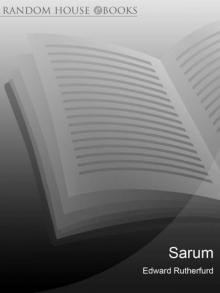 Sarum
Sarum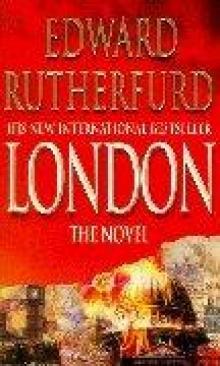 London
London Russka: The Novel of Russia
Russka: The Novel of Russia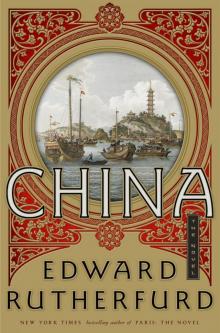 China
China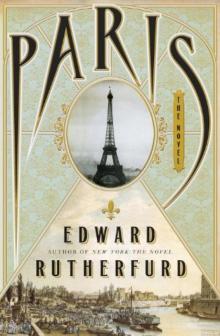 Paris
Paris The Forest
The Forest Russka
Russka The Rebels of Ireland: The Dublin Saga
The Rebels of Ireland: The Dublin Saga The Princes of Ireland
The Princes of Ireland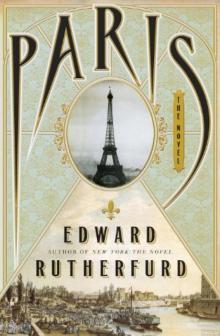 Paris: The Novel
Paris: The Novel